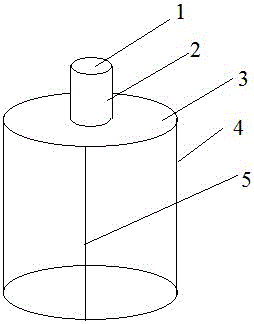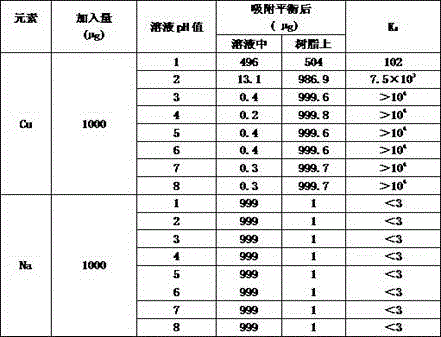Method using static adsorption ion exchange technology to separate and measure copper ions in salt
A static adsorption and ion exchange technology, applied in the field of atomic absorption spectrometry detection, can solve the problems of background interference, difficult measurement, affecting the arc temperature, etc., and achieve the effect of eliminating the problem of spectral interference, improving the speed of separation, and not difficult to operate.
- Summary
- Abstract
- Description
- Claims
- Application Information
AI Technical Summary
Problems solved by technology
Method used
Image
Examples
Embodiment Construction
[0015] The technical solution of the present invention will be further described below in conjunction with specific examples, and these examples should not be construed as limitations on the technical solution.
[0016] 1. Instruments and reagents: atomic absorption spectrometer (Shimadzu A6300C, PE AA800); ultrapure water instrument (Milli-Q); copper standard solution (National Standard Materials Research Center); iminodiacetic acid resin (100~ 200 mesh); cage adsorption device (self-made);
[0017] 2. Experimental process:
[0018] 1. Preparation of the cage adsorption device:
[0019] Make: at the bottom and the side of the cylindrical plastic cage frame 5 with a diameter of 3 cm and a height of 5 cm, seal it with a 200-mesh nylon net 4, add a plastic cover 3 at the top, and open a circular hole with a diameter of 0.6 cm in the center of the plastic cover 3, the circular hole A plastic round pipe 2 with a center hole 1 of 0.6 cm in height and a middle cementing outer di...
PUM
 Login to View More
Login to View More Abstract
Description
Claims
Application Information
 Login to View More
Login to View More - R&D
- Intellectual Property
- Life Sciences
- Materials
- Tech Scout
- Unparalleled Data Quality
- Higher Quality Content
- 60% Fewer Hallucinations
Browse by: Latest US Patents, China's latest patents, Technical Efficacy Thesaurus, Application Domain, Technology Topic, Popular Technical Reports.
© 2025 PatSnap. All rights reserved.Legal|Privacy policy|Modern Slavery Act Transparency Statement|Sitemap|About US| Contact US: help@patsnap.com



